
About the Piece
“Three Portraits of a Witch” was commissioned by The Harford Ballet (Joppa, Maryland) for a “Wizard of Oz” production. Melanie Ortt was choreographer for the premiere performance, which took place on May 20, 2006 at the Amoss Center for the Performing Arts in Bel Air, Maryland, under the baton of Anthony Rivera. The original version was scored for small chamber orchestra. This version has been expanded to full orchestra.
The music consists of three orchestral sketches depicting the Wicked Witch of the West. She is represented by a four-note chord consisting of a minor triad with a major seventh, and this chord is the framework for various musical themes, each representing an aspect of the Wicked Witch of the West. The first movement, “Gulch’s Tirade”, depicts the angry fit of the character Miss Gulch, who wants to take Dorothy’s dog, Toto, away from her. Miss Gulch comes back in Dorothy’s dream as the Wicked Witch, and so this movement is the first depiction of the evil witch. Gulch’s theme is in a quick 6/8 time, with the opening notes of the theme outlining the minor/major seventh chord. Toward the end of the movement is some gentler, more amiable music, depicting Aunt Em’s beseeching Miss Gulch not to take Toto. Gulch’s angry music interrupts Em’s pleas, bringing the movement to an abrupt close.
The second movement, “The Wicked Witch of the West”, depicts the Witch in her true witch form. She is represented by the bass clarinet, and the music begins with an evil-sounding theme, punctuated by eerie flexatone glissandi. Her music gives way to a broad and splendid-sounding theme which marks the appearance of Glinda, the Good Witch. Glinda and the Wicked Witch fight over the ruby slippers, but Glinda prevails. She gives Dorothy the ruby slippers, which are represented by a sprightly theme in the first violins. As the movement ends, Dorothy dances away in the ruby slippers.
“Scene in the Witch’s Forest” finds the Wicked Witch in an angry turmoil over not being able to get the ruby slippers herself. With two pizzicato notes in the strings, she summons her winged monkeys, represented by a playful and quirky theme first in the strings, which are joined in turn by the woodwinds. A snare drum announces the next group the Witch summons, the robotic Winkies, with a mechanical theme in first the woodwinds and then the strings as well, all the while accompanied by the snare drum. The winged monkeys and the Winkies begin to move at the same time, and their two themes are heard simultaneously. An ominous-sounding fanfare in the brass leads the listener back to The Wicked Witch, who ensues another furious dance. As she does this, she is unaware of Dorothy approaching with a bucket of water. Represented by a syncopated rising scale, Dorothy lifts the bucket and then splashes the Wicked Witch, who proceeds to melt away, accordingly, to nothing, thus bringing the piece to a close.
[Program note by the composer]
Instrumentation:
- Piccolo
- Flute 1
- Flute 2
- Oboe 1
- Oboe 2
- Oboe 3
- Clarinet 1
- Clarinet 2
- Bass Clarinet
- Bassoon 1
- Bassoon 2
- Horn 1 in F
- Horn 2 in F
- Trumpet 1
- Trumpet 2
- Trombone 1
- Trombone 2
- Bass Trombone
- Tuba
- Percussion 1
- Bass Drum
- Bell Tree
- Flexatone
- Glockenspiel
- Snare Drum
- Triangle
- Percussion 2
- Crash Cymbals
- Slap Stick
- Snare Drum
- Suspended Cymbal
- Thunder Sheet
- Violin 1
- Violin 2
- Viola
- Violoncello
- Contrabass
About the Composer
Hailed by Lukas Foss as “a master composer,” Lauren Bernofsky has written well over a hundred works, including solo, chamber, and choral music, as well as larger-scale works for orchestra, film, musical, opera, and ballet. Her music has been performed across the United States as well as internationally in major venues from Carnegie Hall to Grieg Hall in Bergen, Norway.
She has over seventy works in print from Theodore Presser, Alfred, Carl Fischer, Boosey & Hawkes, FJH, Hal Leonard, Grand Mesa, Balquhidder, Fatrock Ink, and Wingert-Jones. Her music is often heard at festivals and conferences, including Tanglewood, The Midwest Clinic, and the International Women’s Brass Conference, and it has been played by members of The Metropolitan Opera Orchestra, the Boston Symphony Orchestra, the Atlanta Symphony, the Philadelphia Orchestra, and many others. Recordings of her music can be heard on the Polarfonia, Emeritus, Blue Griffin, MSR Classics, Summit, and Albany labels.
Her works have won the National Flute Association’s Newly Published Music Competition, the Longfellow Chorus Award of Distinction, and an Excellence in Composition Award from the Brass Chamber Music Forum. Bernofsky has received grants from The National Foundation for the Advancement of the Arts, The American Music Center, and The American Composers Forum. Her compositions have been commissioned by The Del Mar Trio, The Holyoke Civic Symphony, The Litchfield County Children’s Choir, The South Shore Conservatory, The International Women’s Brass Conference, Sinfonia Calcania of Boston, The Harford Ballet, Reimagining Opera for Kids, the Bloomington Symphony Orchestra, and Voces Novae. Her music has been performed by members of the Boston Symphony, Atlanta Symphony, Philadelphia Orchestra, Metropolitan Opera Orchestra, and many others.p>
Lauren Bernofsky holds degrees from the Hartt School, New England Conservatory, and Boston University, where she earned a doctorate in composition. She has taught at Boston University, The University of Maryland Baltimore County, The Peabody Institute, and Interlochen, and she regularly serves as a clinician and guest conductor at schools, universities, and regional festivals. [From the composer’s website]
Performance Materials
Performance materials are available from Theodore Presser
Click HERE to view a perusal score.